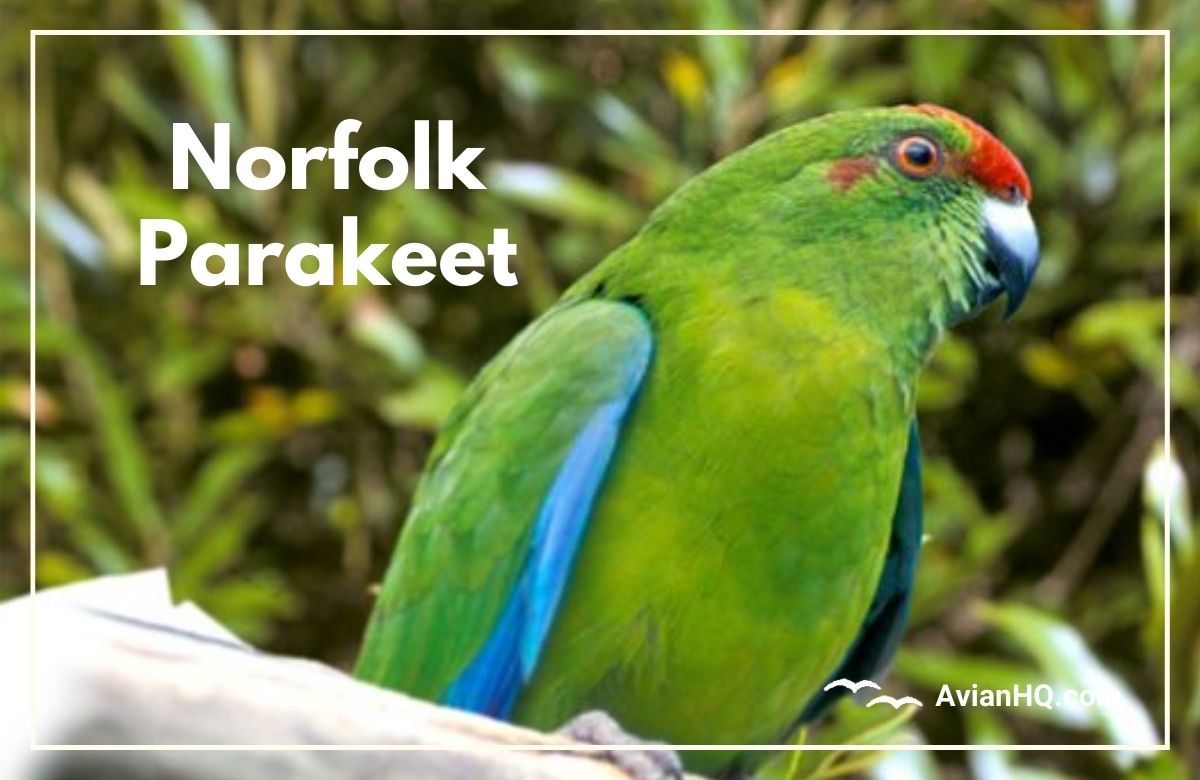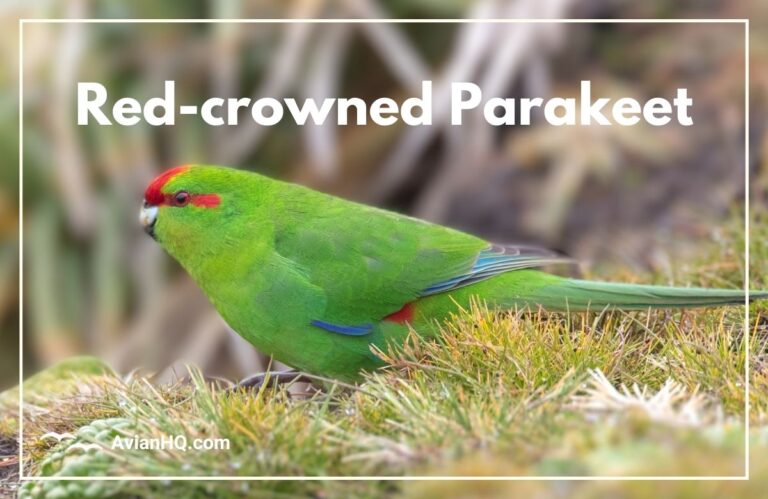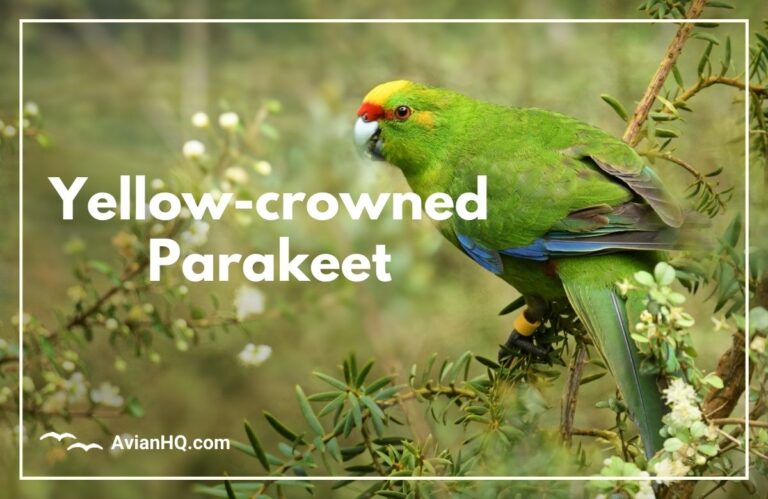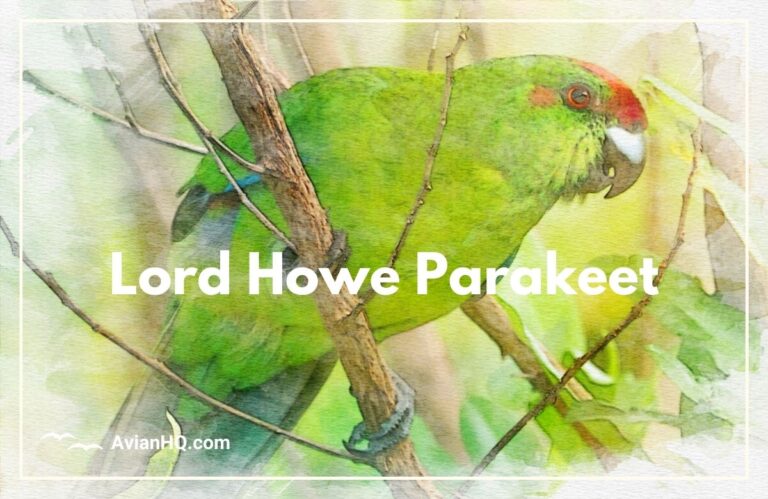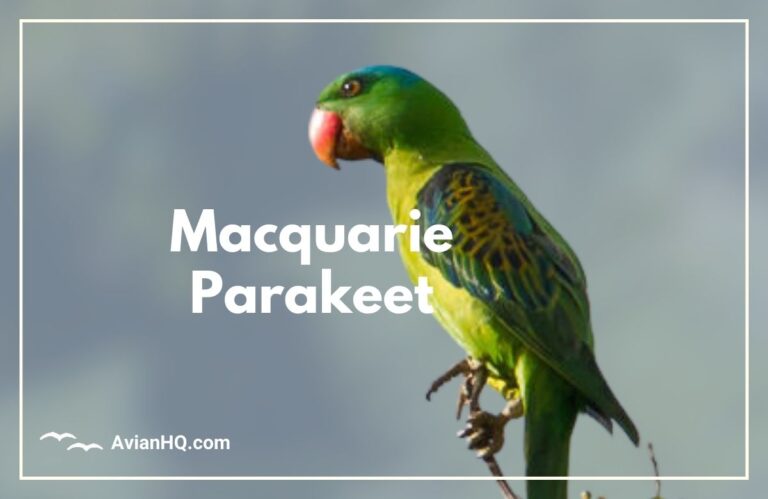Norfolk Parakeet (Cyanoramphus cookii)
You gaze up into the dense, green forest canopy. A flash of bright green and red feathers catches your eye as a parakeet darts through the branches. About 8-10 inches (20-25 cm) long, with elegant tail feathers spreading behind it, this vibrant tropical bird is a marvel to behold.
Welcome to Norfolk Island! This small, isolated volcanic island 600 miles (965 km) off the Australian east coast is home to an array of unique plants and animals. But perhaps none of its endemic species are as striking as the Norfolk Parakeet. Once also called the Norfolk Island Red-fronted Parakeet, this critically endangered bird survives only in a small area of forest that once stretched across the island.
As you’ll learn, the story of the Norfolk Parakeet is one of perseverance against all odds. Having rebounded from just 4 birds in the 1980s, its population now hovers precariously around just 50 adult birds. Conservation efforts gave the species a second chance after they neared extinction. But more action is needed to preserve the biodiversity of Norfolk Island along with its most iconic endemic inhabitant.
“Look deep into nature, and then you will understand everything better.” – Albert Einstein
Through this article tracing the natural history of the Norfolk Parakeet, you’ll gain insight into this island ecosystem and rare species. Understanding the challenges it faces can inspire more thoughtful stewardship of fragile island habitats globally. Join us on an exploration of the ecology, behavior and uncertain future of Australia’s rarest endemic parrot.
History and Taxonomy
The story of the Norfolk Parakeet begins in the early 1800s when Europeans first encountered these unique island birds. British settlers arriving on Norfolk Island spotted flocks of bright green parakeets feeding on nutmeg and laurel trees. Early accounts described them as abundant across the heavily forested island about 1,243 miles (2,000 km) northeast of Sydney, Australia.
It wasn’t until 1790 that British naturalist George Shaw first described the species scientifically under the name Psittacus cookii in honor of Captain James Cook. Later renamed Cyanoramphus cookii, today it bears the common names Norfolk Parakeet or Norfolk Island Green Parakeet. Closely related to other Pacific parakeets, some experts consider them a subspecies of the Red-crowned Parakeet found in New Caledonia.
Distinctive features include the adult male’s bright red band stretching across the forehead above its cherry eyes, bordered by blue feathers. Adult females lack the colored forehead band and exhibit an entirely green head and breast. Once considered the same species as the Tasman Parakeet of New Zealand, differences in size, appearance and calls warranted separating them taxonomically.
As one of Norfolk Island’s only two endemic land birds found nowhere else, early settlers had no idea that this abundant parrot would face imminent extinction…
Physical Appearance
Stretching just 8-10 inches (20-25 cm) from head to tail, the Norfolk Parakeet exhibits a bright green plumage across most of its body. Its back and wings show a yellowish olive-green hue. Meanwhile a richer emerald shade covers the top of its head, cheeks, chin, and underparts. Black feather markings stand out on its bend of wing and undertail.
Vibrant colors decorate adult male birds. The most striking feature is the broad red band stretching above its eyes from beak to nape. Bordered by bright blue feathers above, this fiery forehead makes the males unmistakable. Females instead sport a mostly green head. Both sexes share in common yellow-green feathers covering the thighs along with crimson-colored undertails and wing patches.
Norfolk Parakeets showcase longer tails relative to body length compared to other parrots. This aids tremendously in aerial maneuverability when navigating dense forest. From beak tip to tail tip the birds reach 13-15 inches (33-38 cm) including their elegant tail streamers. Sturdy gray beaks adapted for cracking hard nuts and seeds help the parakeets gather food. And unusually long middle toes give them a secure grip when climbing.
The island’s other endemic land bird – the Norfolk Island Morepork owl – dwarfs the parakeets at over 12 inches tall. But no other species matches the eye-catching hues of a Norfolk Parakeet flashing swiftly through the canopy. Their vibrant green feathers now make them easy targets for illegal collectors and traders who threaten the species’ chance of recovery.
Habitat and Distribution
The Norfolk Parakeet evolved as a resident of the lush subtropical forests blanketing Norfolk Island. Located in the South Pacific Ocean between New Zealand and New Caledonia, this small volcanic island spans just 13 square miles (35 sq km). Conditions vary widely across zones from sea level up to 1,000 feet (300 m) in elevation.
Originally Norfolk Parakeets occupied habitat across most of the island. Dense evergreen forests dominated by Norfolk Island pines once extended over more than 60% of the land area. Broad-leafed trees like the Phillip Island Hibiscus provided additional food sources. The parakeets particularly favored patches of old growth forest where mature trees offered plenty of nesting cavities.
Today after extensive habitat destruction, the parakeets only occupy a tiny 40 hectare (100 acre) remnant of Norfolk Island National Park. Their restricted range centers around Mt. Pitt and Phillips Flats along the northwestern coast. Attempts to reintroduce populations elsewhere so far failed to take hold. Habitat loss severely hampered the recovery of this endemic species.
The Norfolk Parakeet now holds the title of Australia’s rarest endemic parrot. No other parrot exists in such critically low numbers within such a limited distribution. Continued habitat protection and restoration remain key to securing this species. Only through expanding its small swath of remaining forest can the parakeet population ever expand significantly from its precarious state.
Diet and Feeding
The Norfolk Parakeet evolved as a generalist able to exploit a variety of food sources. Their sturdy gray beaks serve as adept seed crackers able to pry open tough outer coatings. A parakeet’s daily survival hinges on finding sufficient nutrition across all seasons.
This species gravitates to trees in the laurel family including the Norfolk Island Pine. Cones and nuts of the pine along with fruit of the Phillip Island Hibiscus provide dietary staples. Parakeets show readiness to sample other nuts, berries, blossoms and occasional insects to round out their intake.
Observations show routine foraging behaviors like clinging vertically or upside down to branches while surveying food sources. The birds utilize their uniquely adapted feet to grip firmly so their beaks stay free to gather items. When flowers or unripe cones get gnawed apart in feeding, fragments rain to the forest floor below.
Breeding pairs often forage together with one adult scanning vigilantly for threats as the other feeds. But Norfolk Parakeets also form large communal flocks, especially when food sources become scarce. Up to 30-50 birds may converge on fruiting trees or other abundant resources. Safety in numbers allows more relaxed feeding.
Norfolk Parakeets play a key role in seed dispersal and pollination across the native ecosystem. Their survival directly impacts regeneration of the island’s threatened plant species. Preventing the extinction of this endemic parrot remains intertwined with broader habitat preservation efforts.
Breeding and Reproduction
The breeding ecology of Norfolk Parakeets revolves around their ability to locate scarce nesting cavities. Like other parrots they require tree hollows or similar enclosed spaces to safely rear young. But suitable holes only form over time in mature trees – increasingly rare on Norfolk Island.
Breeding season falls between November and March during the Austral summer. Monogamous pairs stay loyal across years. Courtship displays involve the male repeatedly bowing, spreading wings and tail while making chuckling vocalizations. If a female accepts the male, the two then inspect potential nest sites together.
Favored nesting holes around 13 inches (35 cm) deep get lined with a bed of wood chips chewed by the birds. The female then lays a small clutch of just 2-4 white eggs. She performs all incubation duties over 18-20 days while relying on her partner to deliver meals to the nest.
Chicks hatch blind and helpless but grow quickly under devoted care. Both parents share duties feeding regurgitated plant material and insects to the demanding squeaking nestlings. Young fledge at 6-7 weeks but continue roosting in the family territory several more weeks while learning to forage.
Raising even a single clutch taxes the endangered birds. Producing multiple successful broods per year proves essential to any potential population growth. But the parakeets’ future depends first on there being enough suitable and safe nesting trees available across their restricted habitat.
Behavior and Ecology
Norfolk Parakeets showcase a high degree of intelligence and social complexity similar to other parrots. They spend the majority of time interacting within a flock of 10-20 birds that cooperatively feed, roost and even breed communally. These bonded social groups likely include extended family members along with unrelated friends.
Pairs or trios break off periodically from a flock’s daily routines to tend hidden nests. But parenting duties don’t overwhelm the broader social contact so vital to the parakeets’ wellbeing. Loss of a flock mate gets mourned behaviorally similar to grieving rituals of elephants and primates. And juvenile parakeets enjoy protection and learning afforded by group unity.
Vocal communication facilitates all facets of social structure. Researchers identify over a dozen distinct vocalizations used in every situation from feeding and bonding to alarm calls alerting others about threats. Variations help differentiate between terrestrial or aerial predators like owls, hawks or humans.
Norfolk Parakeets remain activity during daylight hours spent alternating between feeding and resting periods. Their ability to fly swiftly over half a mile (>1 km) daily gives them great familiarity of resources across their home range. Flocks congregate in evening at treetop roosts, but pairs break away once again near dawn to start another busy day.
Conservation Status
The Norfolk Parakeet represents one of most dramatic cases of a species saved from absolute extinction. Originally abundant, its population underwent a catastrophic decline as Norfolk Island’s forests got steadily decimated after human settlement. By 1975 only about 50 Norfolk Parakeets barely clung to survival.
Listed as Critically Endangered, the dire outlook led to an emergency captive breeding effort. The total population bottomed out around just 4 remaining birds in 1986. But after successful captive rearing and reintroduction, today a population estimated between 43-57 Norfolk Parakeets fights for survival in the wild.
While no longer at immediate risk of extinction, the species remains endangered by an array of threats:
- Habitat loss and degradation
- Nest site competition from invasive bees
- Overgrazing pressure from introduced livestock
- Illegal poaching for the pet trade
- Disease susceptibility in small populations
Multiple groups like the Norfolk Island Regional Council, Australasian Native Orchid Society and Australian government contribute resources protecting the Norfolk Parakeet. Efforts aim to regenerate native forest, expand the existing habitat, curb non-native species impacts, enforce trade restrictions, and sustainably manage tourist activities.
But recovery depends on continued expansion of protected lands. Until Norfolk Parakeets regain stable connectivity to more nesting and feeding habitat, their future hangs at risk. Ongoing habitat restoration offers the only hope of down listing this flagship species from its precarious position on the brink of extinction.
Cultural Significance
The natural heritage of Norfolk Island remains interwoven with its unique endemic species found nowhere else on Earth. The colorful and charismatic Norfolk Parakeet encapsulates the delicate island ecology that early Polynesian and European settlers exploited to the verge of collapse. This bird symbolizes both the fragility and resilience of the natural world.
Many of Norfolk Island’s endemic plants and animals trace back to early colonizers arriving across ocean currents or air flows. Over millions of years isolated endemic lifeforms like the Norfolk Parakeet evolved to play irreplaceable roles distributing seeds and pollen across the island’s ecosystems. Protecting Norfolk’s cultural identity involves preserving its threatened ecological communities.
As one of the most endangered birds in Australia or Oceania, the Norfolk Parakeet serves as an important flagship to bring awareness and funding to the island’s conservation needs. Its verdant green feathers feature prominently on logos for local conservation groups and sustainable businesses. Images of the parakeet draw crucial tourism dollars that support habitat regeneration projects when managed responsibly.
In effect, saving this parakeet encapsulates hope for restoring balance to the delicate island habitat. An ecological tragedy nearly extinguished this bird forever. But thanks to passionate action, the darling bird of Norfolk Island persists today as part of the island’s rebirth.
Conclusion
As our exploration of this rare parrot illustrates, the Norfolk Parakeet stands today as one of Earth’s most inspiring conservation success stories. It returned from the brink after humans nearly erased this species forever. Yet its future remains intertwined with ongoing habitat protection across its island home.
Beyond just preserving an iconic bird, saving the Norfolk Parakeet offers hope for restoring the vibrant forests and threatened ecological communities once found across Norfolk Island. Its recovery reminds us that even after facing extreme losses, with prompt and bold action, some endangered species can be snatched from extinction’s grip.
“In the end we will conserve only what we love, we will love only what we understand, and we will understand only what we are taught.” – Baba Dioum
The story of the Norfolk Parakeet must serve as a lesson to tread lightly and respectfully across the precious habitats that sustain life in all its diversity. This parakeet’s small victory gives us hope that, if we learn from past mistakes and work tirelessly to heal scars upon the land, life may continue on – colorful, resilient and forever awe-inspiring.

